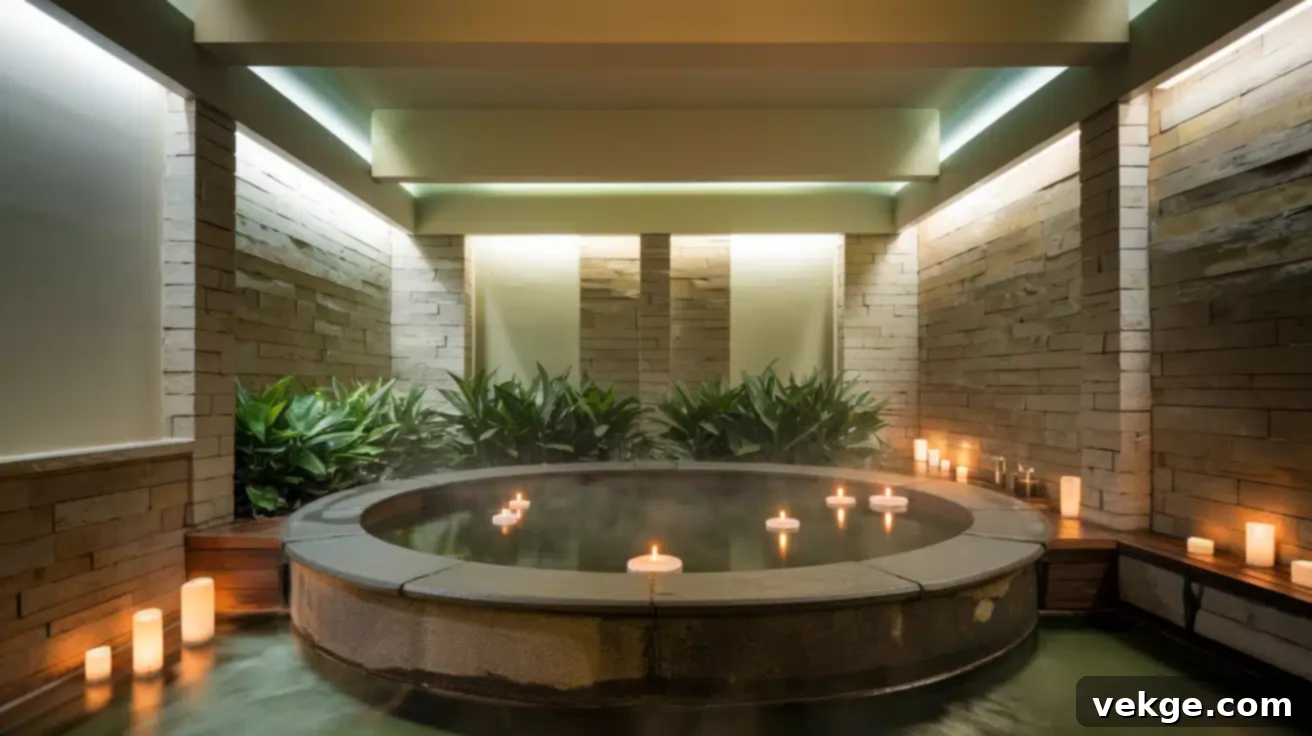Transform Your Spa: 11 Essential Design Ideas for Ultimate Relaxation & Business Success
When clients step into a spa, they’re not merely seeking a service; they are searching for an immersive escape, a sanctuary where daily stresses melt away. The unique look and feel of your spa can profoundly influence whether a visit is a one-time transaction or the beginning of a loyal, lasting relationship. A thoughtfully designed spa space acts as an immediate balm for the senses, fostering a profound sense of calm that encourages clients to leave their worries at the door and fully embrace rejuvenation.
Extensive research consistently demonstrates that intentional spa design directly correlates with enhanced business success. Environments that prioritize client comfort and well-being naturally lead to superior reviews, increased referrals, and a significant boost in bookings. This comprehensive guide unveils 11 practical and innovative spa design ideas, meticulously crafted to help you transform any space into a distinctive haven for complete relaxation and renewal. From fundamental color psychology to advanced sensory integration, these approaches are designed to cultivate the perfect setting for an unforgettable wellness journey.
Why Exceptional Spa Design Is Crucial for Your Business
Exceptional spa design extends far beyond mere aesthetics; it’s about meticulously crafting an atmosphere that operates harmoniously on multiple levels. When your spa’s design is executed flawlessly, the benefits ripple outward, positively impacting every individual who enters your establishment—clients, staff, and ultimately, your bottom line.
Profound Impact on Client Relaxation and Well-being
Clients typically visit spas with a primary goal: to relax, de-stress, and momentarily escape the relentless demands of their daily lives. The right design facilitates this mental shift from the very instant they cross your threshold. Serene spaces, characterized by soft, tactile textures, gentle, ambient sounds, and subtle, inviting scents, collectively signal to the brain that it’s time to unwind and let go. Studies in environmental psychology confirm that individuals respond to their surroundings on both conscious and subconscious planes.
A well-conceived spa design helps clients feel inherently safe, profoundly comfortable, and completely ready to fully immerse themselves in and benefit from their chosen treatments. This immediate sense of ease and belonging is fundamental to fostering a truly transformative spa experience, encouraging deeper relaxation and greater satisfaction.
Positive Effect on Staff Productivity and Morale
The thoughtful design of your spa also significantly influences your dedicated team. Staff members who work in pleasant, ergonomically considered, and aesthetically pleasing environments tend to be happier, more focused, and ultimately more productive. A workspace that feels genuinely good to be in actively reduces mental fatigue and acts as a powerful preventative measure against burnout, a common challenge in demanding service industries.
Furthermore, when treatment rooms are intuitively laid out with all necessary supplies and equipment easily within reach, therapists can perform their duties more smoothly and efficiently, allowing them to deliver even higher quality care to clients. Good design also streamlines the often-overlooked tasks of cleaning and maintaining the space, saving valuable time and effort, and ensuring the spa consistently presents a pristine and professional appearance.
Direct Benefits for Sustainable Business Growth
Smart, strategic spa design directly and positively impacts your financial bottom line. An irresistibly inviting and memorable space acts as a powerful magnet, attracting a steady stream of new clients while simultaneously encouraging your existing clientele to return time and again. When people feel genuinely good and cared for within your spa, they are far more inclined to rebook services, extend their visits (and thus their spending), and enthusiastically share their positive experiences with friends, family, and colleagues through word-of-mouth referrals.
Beyond this, exceptional design inherently creates stunning photo opportunities that are invaluable for your social media presence and marketing materials. Visually appealing spaces help your spa stand out distinctly from competitors, enhancing your brand’s reputation and reach. An aesthetically pleasing and functional design is not just a luxury; it’s a strategic investment in sustained business growth and long-term profitability.
Essential Spa Design Ideas for Creating a Calming Oasis
To truly cultivate a deeply relaxing and restorative spa environment, several key design elements are absolutely indispensable. These foundational ideas possess the power to transform even the most basic space into an extraordinary sanctuary of calm and wellness.
1. Calm, Harmonious Color Choices

Colors are fundamental mood-setters in any environment, and in a spa, they are paramount. Soft, muted, and tranquil tones are unequivocally the best choices for evoking a profound sense of peace and serenity. Hues like light blues and gentle greens are particularly effective as they are strongly associated with nature, known to subtly lower blood pressure and heart rate, promoting a physiological state of calm.
Warm beiges, subtle grays, and rich, earthy tones contribute to a feeling of coziness, security, and grounding. It is crucial to maintain a simple, cohesive color scheme; an excessive number of disparate colors can make a space feel chaotic, visually distracting, and detrimental to mental repose. Consider painting primary walls in neutral shades, reserving pops of calming color for easily interchangeable accents like plush towels, decorative cushions, or subtle art pieces, allowing for flexibility and seasonal updates.
2. Incorporating Natural Materials
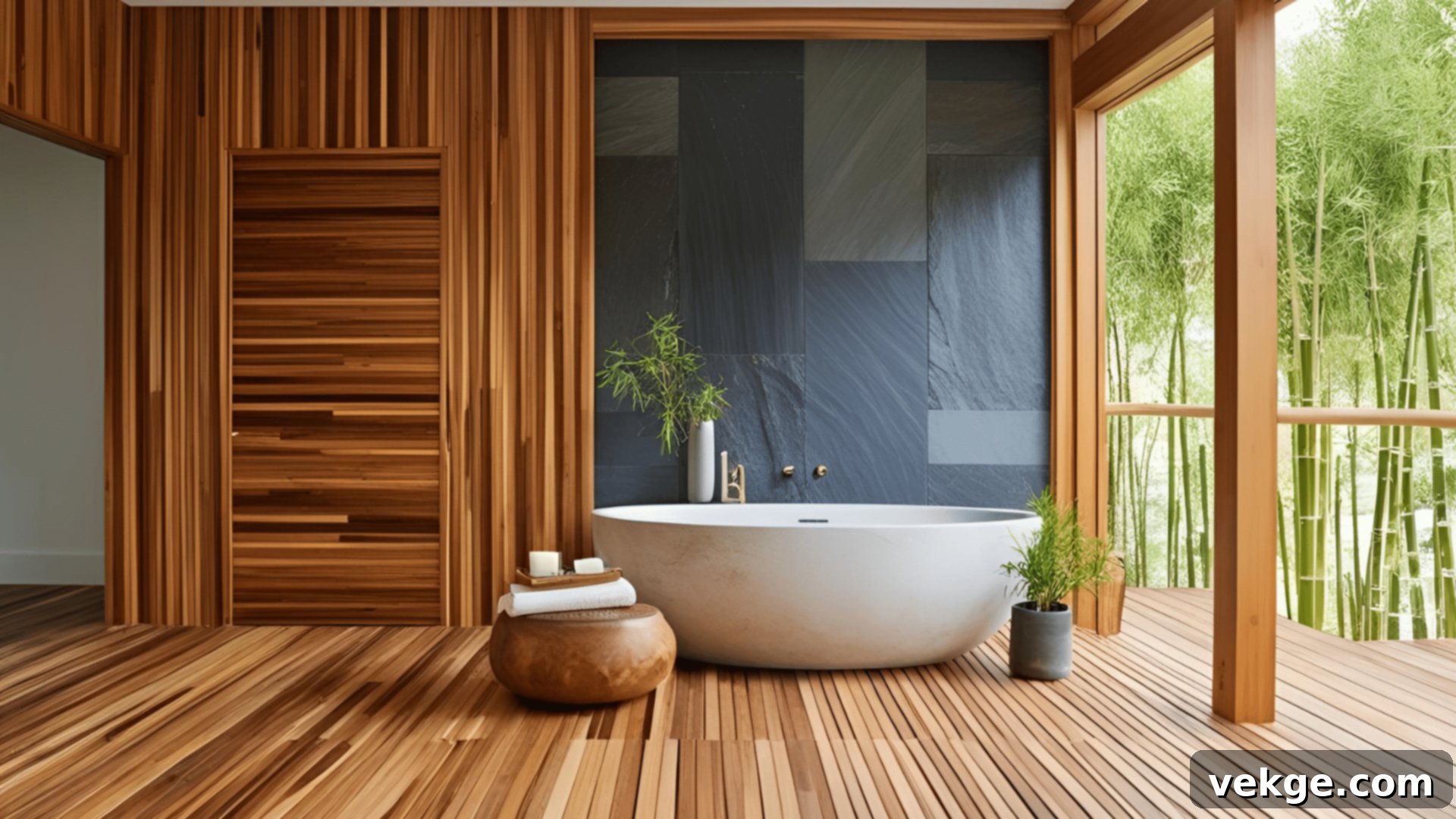
Integrating natural materials into your spa’s design fosters a vital connection to the outdoor world, which is inherently beneficial for stress relief and mental well-being. Wood, with its inherent warmth and organic texture, can be beautifully incorporated into flooring, wall accents, and furniture, instantly creating an inviting and earthy ambiance. Stone elements, such as refined slate or luxurious marble, introduce tactile texture, a sense of timeless stability, and understated elegance.
Bamboo, a highly sustainable resource, adds a light, contemporary, and distinctly natural touch to various spaces. These materials offer a pleasing tactile experience and contribute to a more authentic and grounded environment compared to artificial or heavily processed alternatives. Moreover, natural materials tend to age gracefully, developing unique character and patina over time rather than simply looking worn or dated.
3. The Beauty and Benefits of Indoor Plants and Greenery
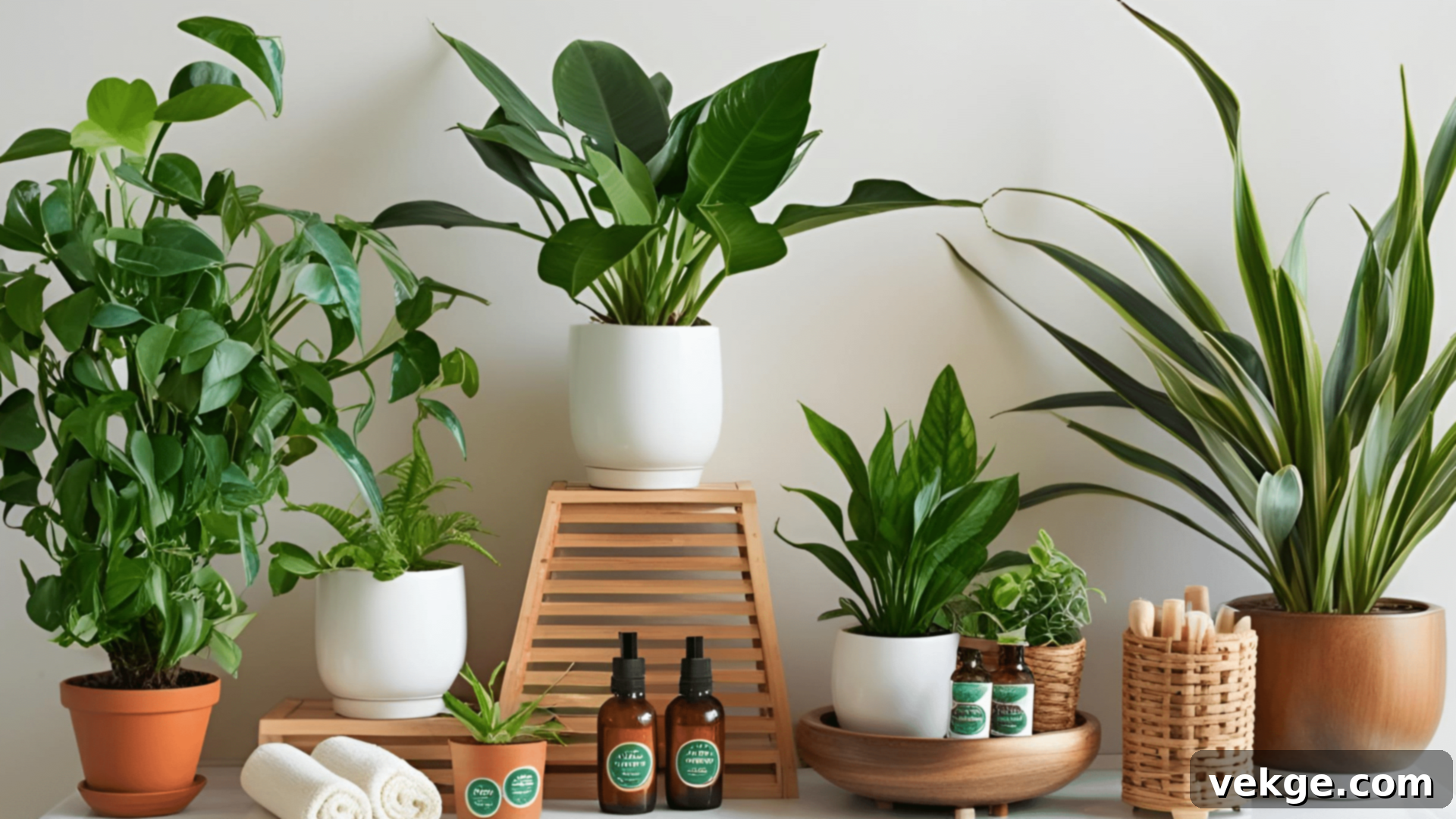
Enriching your spa with living plants offers a multitude of benefits that extend beyond mere decoration. Plants are natural air purifiers, efficiently removing toxins and replenishing oxygen, thereby enhancing the overall air quality. They introduce vibrant life, organic beauty, and a tangible connection to nature within any space. Even small, strategically placed plants on shelves, reception desks, or treatment room counters can make a significant positive impact on the atmosphere.
For low-maintenance yet effective options, consider resilient varieties such as snake plants, pothos, or ZZ plants, which thrive in typical indoor conditions with minimal care requirements. Larger specimens, like elegant palm trees or striking birds of paradise, can serve as stunning focal points and effectively delineate different areas within an open-plan spa. Should your spa have limited natural light, high-quality artificial plants can provide a visually appealing alternative without the upkeep.
4. Thoughtful and Soft Lighting Options
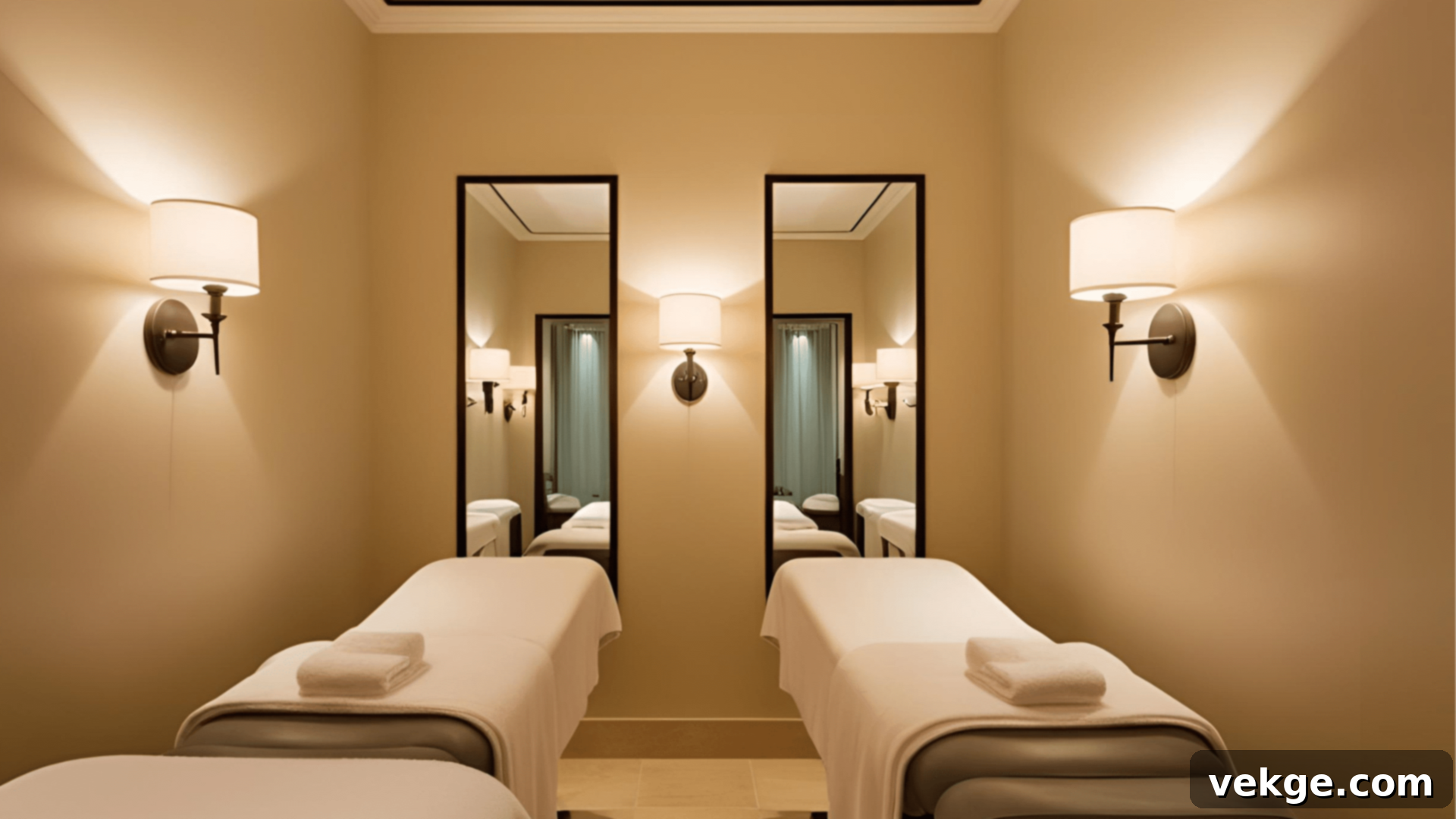
Harsh, overhead lighting is antithetical to the very essence of a spa environment. Instead, the goal should be to implement soft, layered lighting that bathes the space in a warm, inviting glow. Install dimmers on all overhead lights, allowing for precise adjustment of brightness throughout the day and for various treatment types. Wall sconces, positioned at eye level, create a wonderfully flattering, ambient light that makes every client look and feel their best.
LED candles offer the serene flicker of candlelight without any fire hazards or smoke, making them a safe and effective choice for creating intimacy. Crucially, for individual treatment rooms, ensure the lighting can be flexibly adjusted to suit the specific service being performed—brighter, focused illumination for detailed work like facials, and significantly softer, diffused light for massages and relaxation therapies. This adaptability is key to a truly customized client experience.
5. Soothing Water Features
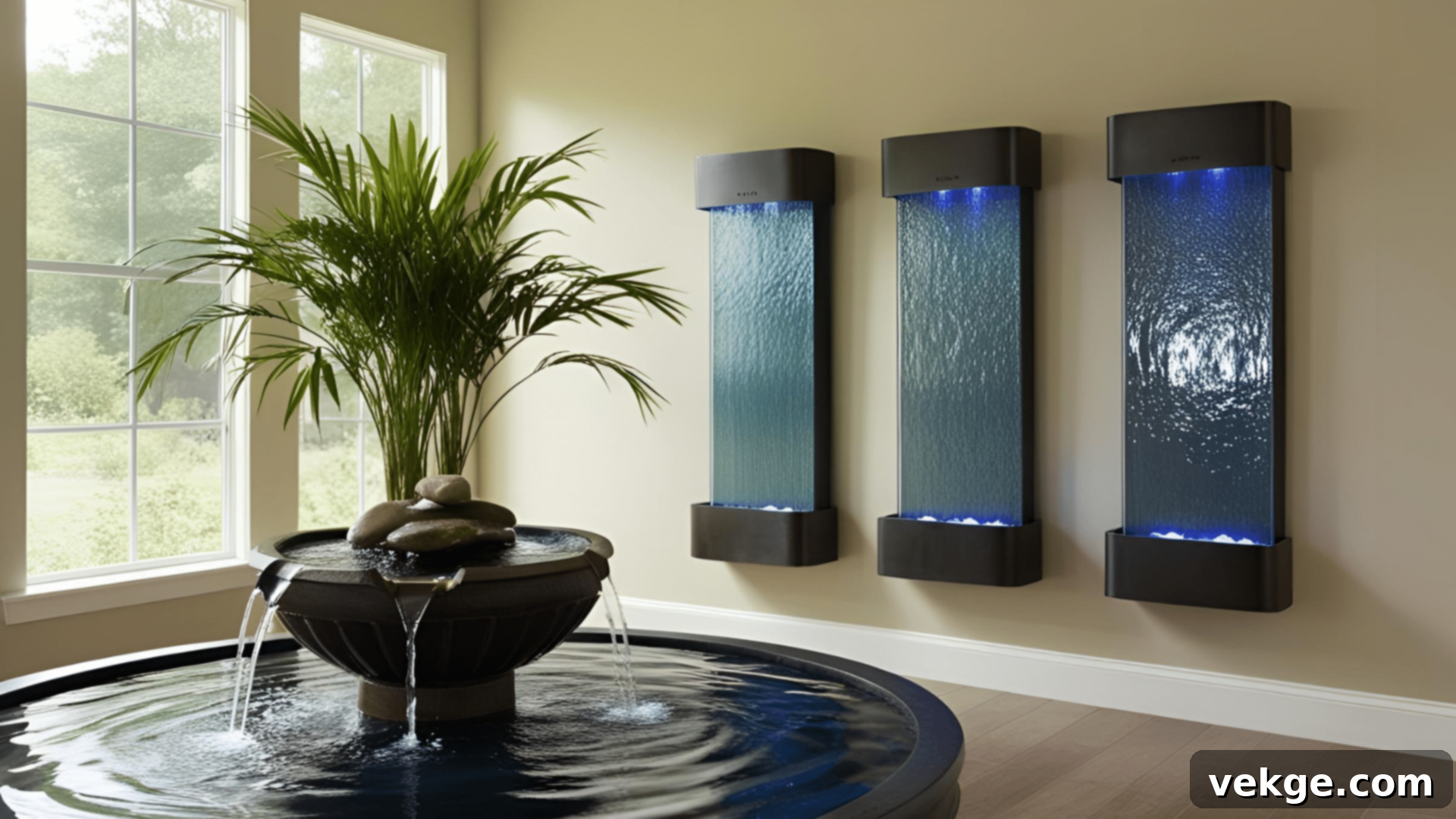
The gentle, rhythmic sound of moving water possesses an incredible ability to mask distracting background noise and instantly induce a state of calm. Even modest water features, such as elegant tabletop fountains, can profoundly enhance the sonic landscape of your spa. Wall-mounted water panels offer both visual intrigue and the creation of consistently soothing sounds. For more expansive spaces, consider incorporating a small, internal waterfall or an artfully bubbling rock feature within the waiting area or common lounge.
If concerns regarding plumbing, maintenance, or space limitations make actual water features impractical, high-quality sound machines that expertly mimic the natural sounds of rainfall, gentle streams, or ocean waves can provide remarkably similar therapeutic benefits, delivering an auditory escape without the logistical complexities.
6. Strategic Scent Selection and Aromatherapy

The sense of smell holds a unique and powerful connection directly to the brain’s emotion and memory centers, making it an extraordinarily potent tool in sophisticated spa design. Lavender is universally recognized for its profound relaxation-promoting properties, while invigorating citrus scents can energize, uplift, and refresh the spirit. Eucalyptus is excellent for clearing airways and instilling a feeling of pristine cleanliness and invigoration.
Regardless of your chosen scents, the key is subtlety; overpowering fragrances can unfortunately trigger headaches or nausea in sensitive clients. Prioritize the use of high-quality essential oils and natural diffusers over synthetic, artificial fragrances. Consider rotating scents seasonally to keep the experience fresh and intriguing. Importantly, always offer scent-free alternatives or clearly communicate your scent profile to accommodate clients with allergies or sensitivities, ensuring a comfortable experience for everyone.
7. Simple, Uncluttered Layouts and Minimalism
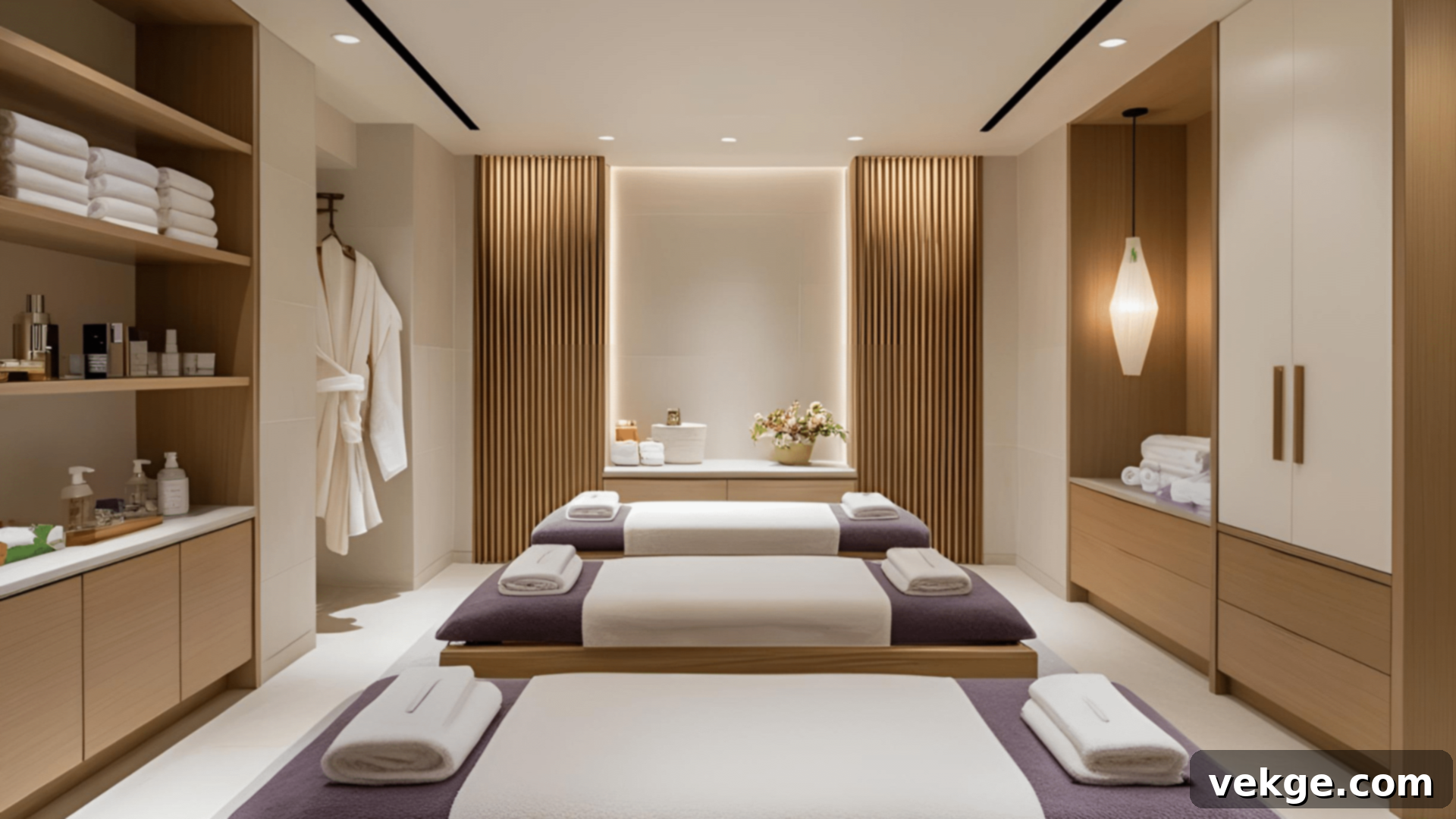
A cluttered physical space inevitably leads to a cluttered mind, making relaxation an uphill battle. Embrace a philosophy of simplicity and openness in your spa’s design. Create clear, intuitive pathways that allow clients and staff to move effortlessly and gracefully between different areas. Essential but unsightly supplies should be discreetly hidden away in integrated cabinetry and elegant storage solutions, rather than left exposed.
Each room within your spa should possess a clear, singular purpose, free from superfluous furniture or distracting decorations. This minimalist approach not only enhances the visual appeal and sophistication of the space but also significantly simplifies cleaning and maintenance. More importantly, it helps clients to focus entirely on their relaxation journey, free from visual noise and distractions, fostering a deeper sense of peace.
Next-Level Spa Design Ideas for Unforgettable Experiences
Once the fundamental principles of exquisite spa design are firmly established, consider elevating your offerings with these advanced concepts. These ideas are designed to create truly unique and memorable experiences that distinguish your spa from the competition.
8. Hyper-Customized Treatment Rooms
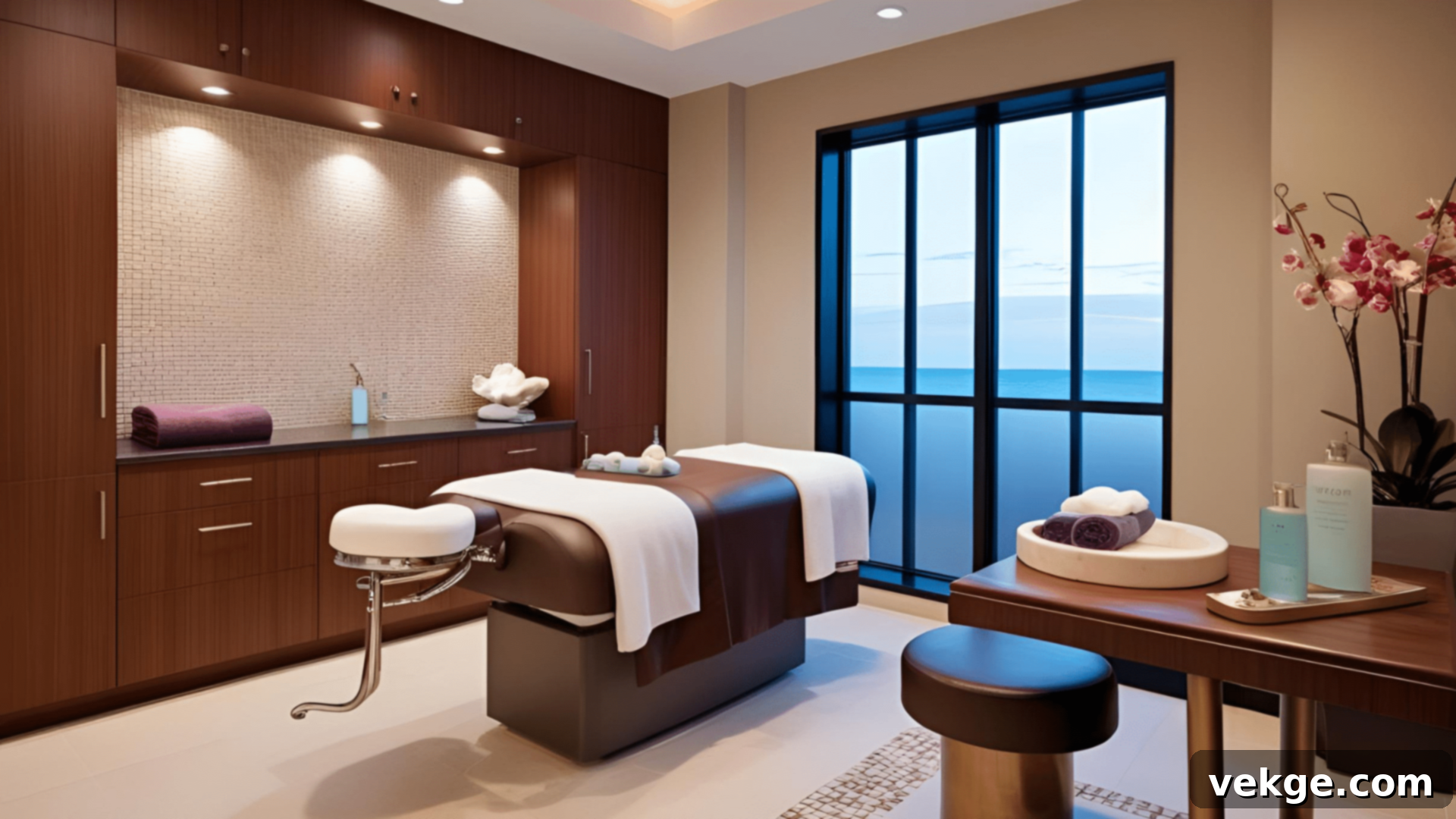
Move beyond standard treatment rooms by incorporating adaptable features that cater to a diverse range of clients and services. This includes sophisticated lighting systems with adjustable color temperatures and hues, individual climate controls for precise temperature settings, and modular, movable furniture configurations. Leading spas are now implementing client-controlled panels, allowing guests to personally select their preferred music, ambient temperature, or lighting color and intensity.
This level of personalization transforms each visit into a uniquely tailored experience, making clients feel genuinely seen and catered to, rather than receiving a generic, one-size-fits-all service. The ability to fine-tune their environment significantly enhances perceived value and satisfaction, fostering deeper engagement and loyalty.
9. Sophisticated Sound System Planning and Acoustics
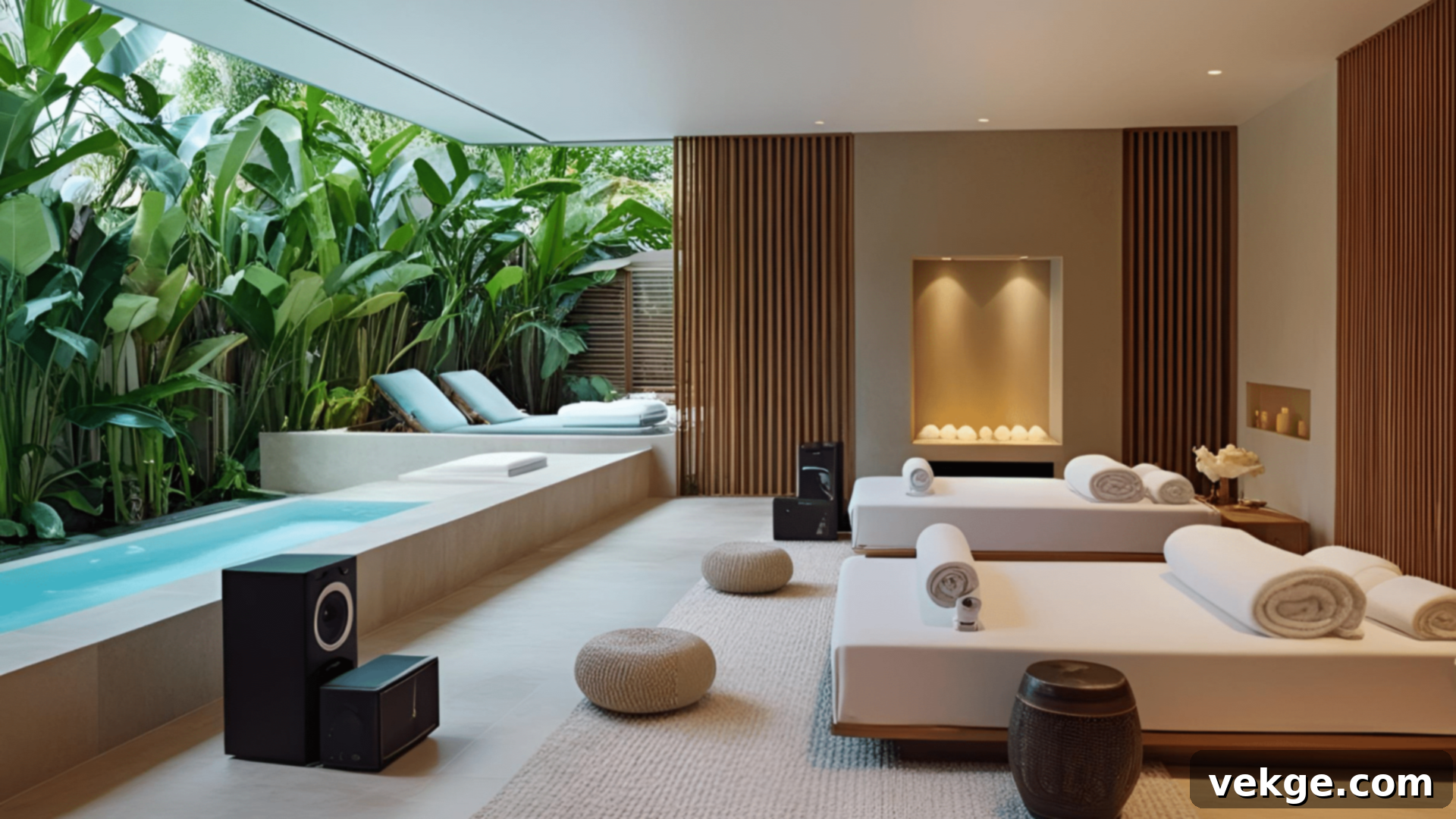
Sound profoundly impacts emotional states and perceived comfort. Invest in a high-quality, professional-grade sound system and meticulously plan its installation to ensure uniform sound distribution across all areas, eliminating pockets that are either too quiet or excessively loud. Install independent volume controls in different zones and rooms; what is appropriate for the bustling reception area is often unsuitable for tranquil massage rooms.
Innovative spas are utilizing directional speakers that focus sound in specific localized spots, creating intimate audio experiences. Research consistently indicates that slower tempo music, ambient soundscapes, or nature sounds significantly aid relaxation. Carefully curate playlists that align with your spa’s theme and the desired emotional response, considering the psychological effects of different frequencies and rhythms.
10. Holistic Sensory Experiences
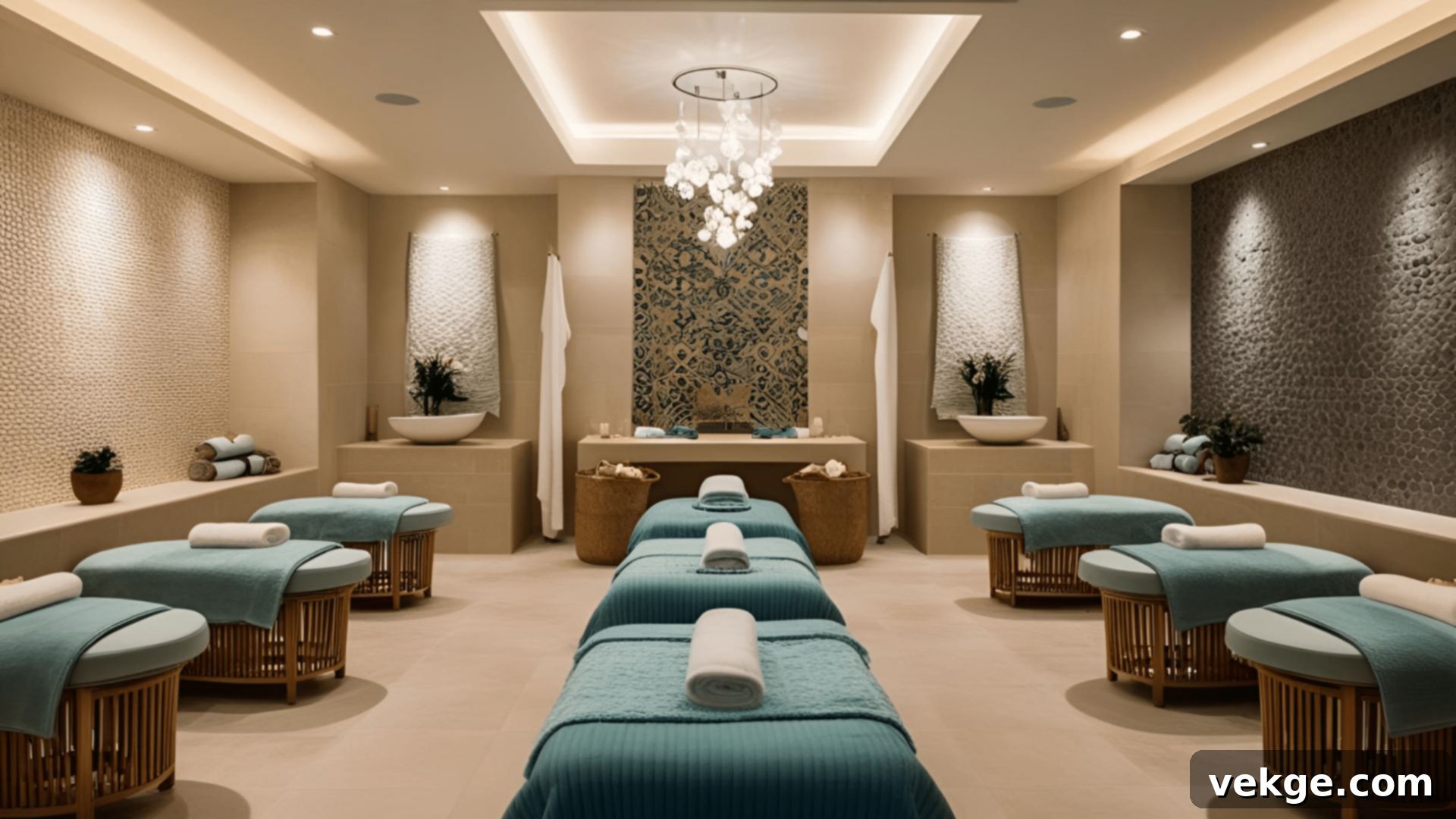
Truly exceptional spa design engages and delights all five senses, moving beyond simple aesthetics. Incorporate varied textures (e.g., soft velvet, rough stone, smooth silk) that invite touch. Play with temperature through heated floors in changing rooms or cool, scented towels offered during warmer months. Introduce gentle movement with subtle ceiling projections of nature scenes or by incorporating weighted blankets during treatments for a sense of grounding and security.
Some advanced spas feature aroma showers that release therapeutic mists, or chairs equipped with gentle, rhythmic vibrations designed to enhance relaxation. These sophisticated, multi-sensory details create a truly immersive and unforgettable experience that standard spas simply cannot replicate, leaving a lasting impression on clients.
11. Distinctive Theme-Based Design

A clearly defined and consistently executed theme makes your spa highly distinctive and provides clients with a complete, cohesive escape. Avoid the pitfall of mixing too many disparate styles, which can lead to a disjointed and confusing aesthetic. A strong theme acts as the guiding principle, connecting all your design choices—from colors and materials to sounds and scents.
For example, a “Forest Retreat” theme might integrate deep forest sounds, extensive wood elements, earthy greens, and pine or cedar scents. An “Ocean Serenity” theme could feature calming blue and white palettes, wave sounds, and marine-inspired textures. Cultural themes also work exceptionally well: minimalist Japanese aesthetics offer clean lines and tranquil simplicity, while Moroccan design can bring rich colors, intricate patterns, and exotic fragrances. The key is for the chosen theme to feel organic and authentic, not forced or artificial.
How to Strategically Choose the Right Spa Design for Your Vision
Selecting the optimal design direction for your spa requires thoughtful consideration and meticulous planning. Here’s a breakdown of crucial factors to deliberate upon.
Aligning Design with Your Spa’s Brand Identity
Before any design decisions are made, you must intimately understand your spa’s core identity. Your design must be a direct reflection of your business values, mission, and the unique experience you aim to provide. For instance, a luxury, high-end spa might opt for opulent textures, rich finishes, and sophisticated color palettes, while a spa focused on holistic or natural healing would lean towards organic materials, earthy tones, and minimalist aesthetics.
Consider your target clientele: what are their expectations, preferences, and desires? Your physical space acts as a powerful storyteller for your brand. Ensure its visual language consistently matches your logo, website, and all marketing communications. This cohesive approach builds a strong, recognizable, and trustworthy brand image.
Prioritizing Functional and Efficient Spaces
While aesthetics are vital, function should always precede form in spa design. Meticulously map out the client journey and staff workflow through your spa. Ensure seamless, intuitive pathways from the moment a client enters the reception area, through waiting zones, to treatment rooms, and finally to changing facilities. Provide ample, comfortable seating in waiting areas that encourages relaxation rather than impatience.
Crucially, do not overlook the importance of intelligent storage solutions. Staff require easy, discreet access to supplies, from fresh towels and therapeutic oils to cleaning equipment. Plan for designated areas for dirty linen and waste management. Physically walk through your proposed layout from both a client’s and a staff member’s perspective to identify and rectify any awkward spots or bottlenecks before construction begins.
Designing Effectively Within Your Budget Constraints
Exceptional design does not necessarily demand an exorbitant budget. Establish clear spending limits early in the planning process. Prioritize investment in areas clients interact with most directly and frequently. For example, high-quality, durable flooring in common areas or premium massage tables might be more impactful than elaborate wall coverings in less-seen spaces.
Smart choices can yield significant results: utilize paint and strategic accent walls instead of costly wallpapers, explore quality second-hand or refurbished furniture, and leverage the visual impact of well-placed plants as an affordable decor element. Shop sales, clearance racks, and local artisans for unique decor pieces. Remember, strategic lighting adjustments can dramatically transform a space without requiring major structural renovations. When working with tight finances, consider a phased approach, updating sections of your spa incrementally over time.
Turning Your Spa Vision into Reality: Practical Steps
Bringing a spa vision that epitomizes comfort and relaxation to fruition demands meticulous planning, from conceptualization to the final touches. Each step must be carefully considered to ensure a space that is both profoundly inviting and impeccably practical.
Collaborating with Experienced Designers and Professionals
Engaging with an experienced interior designer or an architect specializing in wellness spaces is invaluable for translating your vision into a tangible, functional reality. A knowledgeable professional will consider crucial aspects such as optimal space utilization, sophisticated lighting schemes, ergonomic layouts, and the seamless integration of various design elements to create a balanced, harmonious environment. Clear, consistent communication regarding your goals, brand identity, and aesthetic preferences is paramount. This collaborative process ensures a smooth execution and results that precisely align with your expectations, avoiding costly mistakes and maximizing your investment.
Sourcing and Finding Quality Materials
The selection of appropriate, high-quality materials is foundational to your spa’s longevity, aesthetic appeal, and overall comfort. Opt for flooring that is inherently water-resistant and non-slip, ensuring safety and durability in humid environments. Choose durable fixtures and finishes that can withstand constant use and exposure to moisture and various spa products. Natural stone, premium-grade tiles, and specially treated wood are popular choices, celebrated for their inherent strength, timeless beauty, and ability to maintain their pristine appearance over many years.
For example, porcelain tiles offer exceptional durability, superior moisture resistance, and require minimal maintenance, making them a cost-effective, hygienic, and stylish choice for high-traffic and wet areas within a spa. Investing in quality materials initially reduces long-term replacement and repair costs.
Crucial Maintenance Considerations from the Outset
Establishing robust and consistent upkeep practices is absolutely essential for preserving your spa in impeccable condition. From the design phase, prioritize materials and finishes that are inherently easy to clean, sanitize, and maintain. Ensure your ventilation systems are not only efficient but also strategically designed to effectively manage moisture, prevent condensation, and inhibit the growth of mold and mildew, which can compromise both aesthetics and air quality.
Develop a clear, comprehensive cleaning schedule and train your staff on the appropriate products and techniques for each specific material and area. Proactive maintenance will not only preserve the pristine appearance of your space but also significantly extend the lifespan of all your carefully chosen design elements, safeguarding your investment and ensuring a consistently welcoming environment for clients.
Common Spa Design Mistakes to Actively Avoid
While the path to creating a perfect spa is exciting, it’s equally important to be aware of common pitfalls that can undermine your efforts. Avoiding these mistakes will save you time, money, and potential headaches.
- Ignoring Long-Term Maintenance: Some design features might appear stunning but demand extensive, costly, or specialized care. Always opt for materials and design elements that strike a sensible balance between captivating aesthetics and practical, manageable long-term maintenance requirements.
- Poor Ventilation: Inadequate airflow is a silent but significant problem, leading to excessive humidity, unpleasant odors, and the rapid buildup of mold and mildew. Invest in and install highly efficient ventilation systems throughout the spa, especially in wet areas, to rigorously control moisture levels and ensure fresh, healthy air circulation.
- Choosing the Wrong Flooring: Slippery or unsuitable flooring presents a serious safety hazard for both clients and staff, especially in areas prone to water or oil spills. Always prioritize non-slip tiles, textured surfaces, or specially treated wood with appropriate grip to prevent accidents and ensure a secure environment.
- Insufficient Storage Solutions: A cluttered spa environment actively disrupts relaxation and conveys an unprofessional image. Integrate ample, discreet storage for towels, essential oils, cleaning supplies, and other accessories directly into your design. Hidden storage maintains a minimalist aesthetic while keeping everything organized and accessible.
- Improper Lighting: Harsh, bright, or poorly distributed lighting can be jarring, uncomfortable, and detrimental to a calming atmosphere. Steer clear of single-source, overhead lighting. Instead, employ a layered lighting approach with dimmers, soft ambient lights, and warm color temperatures to create a soothing, flattering, and inviting glow in every area.
Conclusion: Crafting a Sanctuary of Serenity and Success
A meticulously designed spa transcends mere visual appeal; it is a meticulously crafted environment that actively fosters deep relaxation, significantly enhances client satisfaction, and directly supports the long-term viability and growth of your business. The journey to creating such a space involves a holistic approach, where every decision contributes to the overall experience.
From the initial selection of the right, durable materials to establishing robust maintenance protocols, and from collaborating with skilled design professionals to implementing innovative sensory elements, each step is crucial for an effective and enduring design. Thoughtful planning ensures a harmonious balance between breathtaking beauty and indispensable practicality, allowing your spa to stand as a true retreat—a sanctuary for both the body and mind.
By diligently applying these comprehensive principles, you can confidently create a spa space that is not only profoundly inviting and deeply restorative for your clients but also exceptionally easy to maintain and operate, solidifying its status as a lasting and invaluable asset for your business for years to come.
